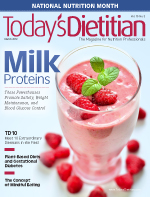
March 2013 Issue
Kimchi — Fermentation at Its Finest
By Bryan Roof, RD, LDN
Today’s Dietitian
Vol. 15 No. 3 P. 66
I know what you’re thinking. Kimchi, by some accounts, isn’t the most glamorous of foodstuffs. But if nothing else, I’d argue that it’s the epitome of fermented foods. Besides, it’s one of my favorite things to eat, and I’m writing this article.
As far as kimchi goes, there are more than 100 varieties, and in some form, it usually graces the table of every Korean meal as one of several banchan, or condiments, that accent the entrée(s).
My mother spent years living in Korea, and I inherited the taste for kimchi from her—although not willingly in my younger years. It has a bit of an odor for the uninitiated, and it can be rather pungent compared with most other fermented foods. I do know that I can’t get enough of the stuff now, but that’s not necessarily bad.
Fermented foods like kimchi are among the best for your immunity and digestive system, as they’re an excellent source of probiotics. Fermentation elicits the help of microbes to create a sour environment—or, more precisely, an acidic environment—to preserve, develop the flavor, and change the nutritional and enzymatic properties of the food in question. And as Alex Lewin notes in his book Real Food Fermentation, “The microbes responsible for fermentation often create enzymes and vitamins, break down difficult-to-digest food components, and make minerals more available for your body to assimilate.” Not bad for some stinky cabbage.
I’ve gotten into the habit of making my own kimchi, and it’s embarrassingly simple. However, I’m not featuring that recipe here. Instead, I’ll work under the assumption that you’ve befriended your local Korean grocer halfway through reading this story and are now staring eyeball to eyeball with a large jar of kimchi. Most likely you bought one of the most typical varieties made with Napa cabbage. When you’re done heaping mounds of it over steaming bowls of rice, I recommend making kimchijeon (kimchi pancakes).
— Bryan Roof, RD, LDN, is a chef, dietitian, and food writer living in Boston. Follow him on Twitter at @bryanroof.
Kimchijeon (Kimchi Pancakes)
Serve this pancake with a sauce of equal parts soy sauce and vinegar and sesame oil to taste.
Serves 4 as an appetizer
Ingredients
1 cup Napa cabbage kimchi, squeezed dry and chopped (6 oz)
4 scallions, cut into 1/2-inch pieces
1/2 cup mung bean sprouts (1 1/2 oz)
1/2 cup cold water
1/4 cup all-purpose flour
1/4 cup cornstarch
1 large egg
1 tsp toasted sesame oil
1/2 tsp sugar
1 T olive oil
Directions
1. Stir together in a bowl all ingredients except the olive oil until just combined.
2. Heat the olive oil in a 12-inch nonstick skillet over medium-high heat until just smoking. Add pancake batter and spread evenly across pan bottom. Cook until the underside of the pancake is well browned and crispy, about 2 minutes. Flip pancake and cook on the second side until well browned, about 11/2 minutes. Flip pancake over once more to recrisp first side.
3. Turn out pancake onto wire rack and let cool slightly, about 3 minutes. Cut pancake into wedges or squares and serve.
Nutrient Analysis per serving
Calories: 150; Total fat: 6 g; Sat fat: 1 g; Trans fat: 0 g; Cholesterol: 55 mg; Sodium: 390 mg; Total carbohydrate: 18 g; Dietary fiber: 2 g; Sugars: 3 g; Protein: 5 g
